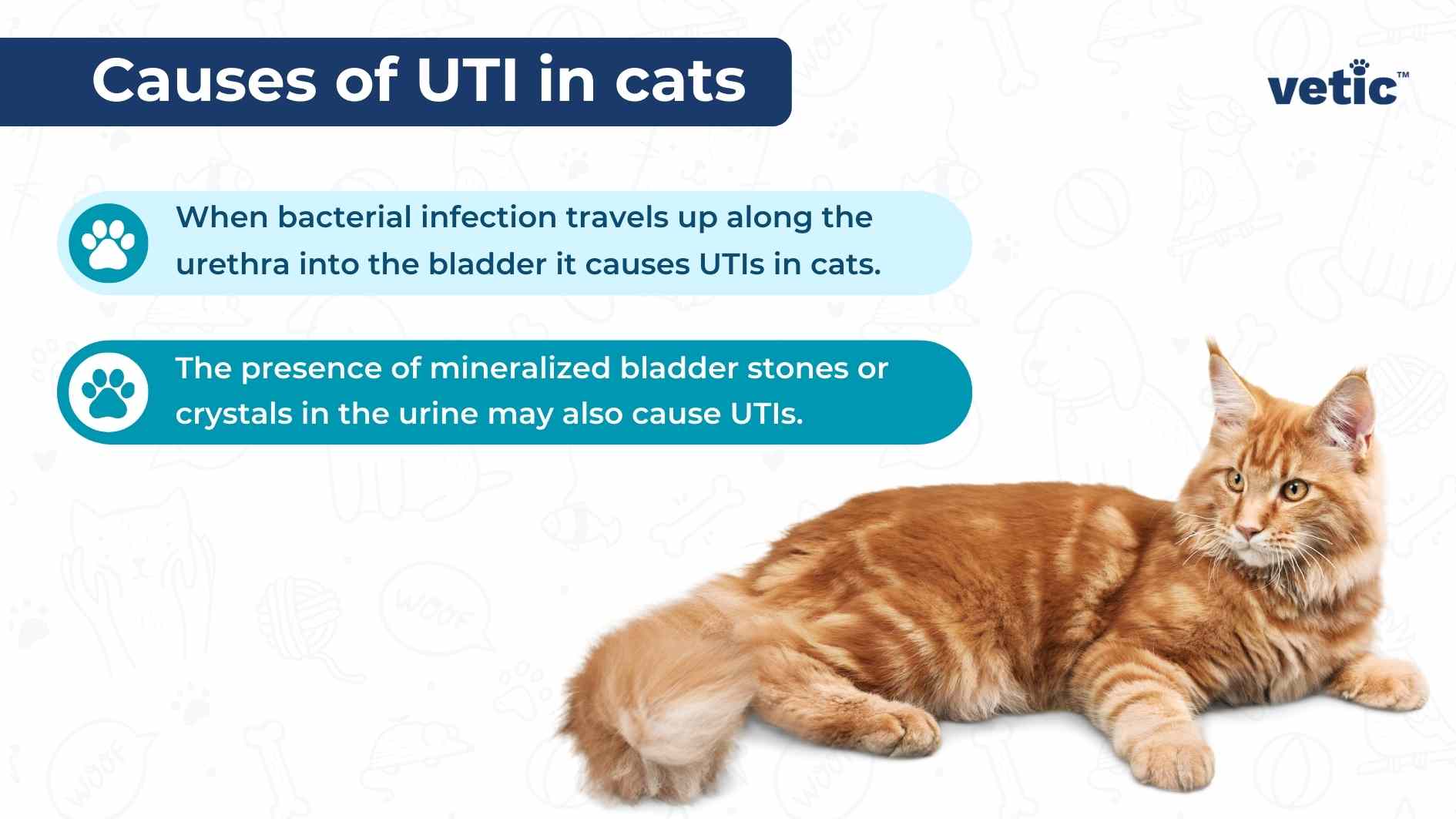Around 1-3% of cats with urinary discomfort have UTIs. UTI in cats is common but Urinary tract disorders are very common among cats.
The signs of UTI are similar to the signs of other urinary tract conditions in cats. So, if your cat is showing any kind of distress while urinating or exhibiting litter box aversion, you need to take your cat immediately to the veterinarian for a check-up.
The veterinarian will run multiple tests to determine whether your cat has a UTI or if there is some other reason, such as urinary crystals or bladder stones, for their distress.
Signs of Urinary Tract Infections (UTI) in cats

UTIs cannot be diagnosed from signs of urinary discomfort. However, some signs of UTI in cats include –
- Frequent urination
- Small quantities of urine
- Blood in the urine
- Difficulty in urinating
- Litter box avoidance
- Crying or loud mewing during urination
- Over-licking of the urinary opening
Some cats may also vomit, show complete inappetence, and become lethargic within 24 hours of showing the first signs of UTI.
How Can You Tell If Your Cat Has a UTI or Urinary Tract Disorder?
Cats’ body language tells a lot about their health and mental state.
If you have seen your kitten grow up into a gorgeous and elegant cat, you may notice some changes in their behavior when they are experiencing urinary tract disorders.
For example, some physical signs of UTI in cats include –
- A heavily arched back while peeing
- Head held downwards
- Ears flattened
- Eyes almost closed while peeing
- Marked muzzle tension
- Whiskers held almost erect
These are all marked signs of pain and discomfort in cats according to the updated grimace scales in cats.
What Causes UTI in Cats?

A UTI is a bacterial infection that typically ascends from the urethra to the bladder. In more severe cases, the kidneys may become involved as well.
The external causes can range from unclean litter boxes or too few litter boxes for multiple cats.
How is UTI Diagnosed?
Urinary distress doesn’t always mean UTI in cats. So, your veterinarian will want to perform a complete urinalysis.
Urinalysis will include the following –
- Urine Specific Gravity
- The pH of your cat’s urine
- Glucose levels
- Urine Bilirubin
- Blood or RBC
- Urine Protein
This is typically followed by a microscopic examination. It can reveal whether there are crystals in the urine.
Your veterinarian might also recommend an X-ray and USG to look for further causes of your cat’s distress if there are no bacteria present in their urine sample.
What is a Urine Culture and Sensitivity Test for UTI in Cats?
Your cat may have a UTI, but not all UTIs are equal. A UTI is a bacterial infection but the species of bacteria can differ between two cats showing the same signs of UTI.
The most common bacteria that cause UTI in cats is Escherichia coli or E coli. Nonetheless, there can be another species or multiple bacteria involved in the infection.
The only way to find out which bacteria are involved in the UTI is to culture (grow) them in laboratory conditions. It typically takes around 24 hours.
The next step is to see which antibiotics can effectively kill these bacteria without causing harm to your cat. This part is known as the sensitivity test and it takes around another 24 hours.
Your veterinarian may prescribe a broad-spectrum antibiotic when your cat begins presenting these signs to clear up most of the infection.
However, the urinalysis urine culture and sensitivity tests will help the veterinarian decide exactly which antibiotics will work best to clear the infection.
Once your cat finishes the course of antibiotics for UTI in cats, your vet will again recommend another culture to see if there are any further bacterial growths in the bladder or urethra.
What is the Treatment for UTI in Cats?

The choice of treatment for UTI in Cats is always antibiotics.
We do not recommend trying natural remedies for UTI in cats since UTI can become an emergency if not treated properly and on time.
Moreover, the side effects of many common food items (berries and herbs) have not been tested on cats. While they might be great in treating UTI in humans, they may cause digestive distress and further complications in our feline companions.
Please refrain from using natural remedies for UTIs in cats.
Visit the veterinarian and make sure your cat completes the prescribed course of antibiotics for UTI in cats.
Which cats are at a Higher Risk of UTI?
Female cats are always at a higher risk of developing UTI as compared to male cats. At the same time, veterinarians note UTIs more frequently among older female cats.
Some existing medical conditions predispose certain cats to UTI, for example –
- Diabetes mellitus
- Kidney issues
- Immunosuppression
- Hyperthyroidism
- Bladder stones
In most cats with these chronic health conditions, UTI becomes a stubborn issue despite proper medical treatment.
How Can You Prevent UTI in Your Cat?
Your veterinarian may recommend specific prescription diets to support your cat’s urinary health.
You should also revisit your litter box hygiene practices.
If your cat has any of the above-mentioned predisposing factors, you should consider getting them treated to reduce their risk.
If your veterinarian recommends supplements for urinary health, continue them for the prescribed period even after the signs of UTI subside.
Feel free to contact our veterinarians if you have any more questions about UTI in cats and their prevention.
